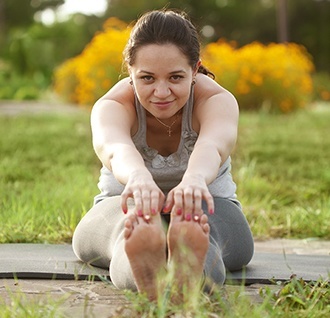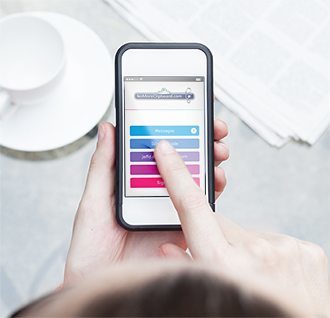It's free and easy to start managing your health information online with a NoMoreClipboard PHR.







Find out how your patients are using PHRs by creating one for yourself and your family!
A NoMoreClipboard account includes PHRs for up to 10 family members, free. Start one yourself and see how easy Better. Managed. can be — for you and your patients.
NoMoreClipboard portals and PHRs are actively demonstrating the dual benefits of increased engagement and improved outcomes to both users and use cases alike. Private practice physicians, clinics and small hospitals appreciate the productivity gains they experience with self-service patient tools for scheduling and prescription refill requests, and the integrated PHR provides a seamless workflow for MU2 V/D/T requirements.
HIEs are integrating portals as a value-added service to their providers, who can take their first steps toward electronic patient engagement at an attractive price point. Employers are also seeing benefit as they assume an increasing role in employee health and wellness, supported and powered by NoMoreClipboard.
But it’s the patients themselves who experience the highest value — a convenient, easy to use toolset for monitoring, managing and preventing chronic disease, improving coordination of care, retrieving laboratory results and consolidating family health records in a single, secure, online location — accessible from anywhere, anytime.
In addition to meeting patient engagement requirements for Meaningful Use Stage 2, physician practices experience immediate and ongoing productivity improvements with portals powered by NoMoreClipboard. Patients use self-service tools for requesting appointments and refills, and completing pre-registration paperwork online, reducing the administrative burden on the practice. Call backs can be completed on the nursing staff’s schedule, reducing the interruptions that compromise efficiency and quality of care.
Two hundred Parkview Physicians Group Cardiology (PPGC) revascularization patients — most between the ages of 56 and 74 — used electronic personal health records (ePHRs) to monitor and manage chronic cardiac conditions. PPGC is an Indiana Challenge Grant pilot site, and a recent study provided ePHRs pre-populated with data from the practice’s EHR, along with training on how to use the ePHR. Baseline lab testing captured patient weight, blood pressure, lipid and HbA1c levels, and assessed the patients’ engagement using the Patient Activation Measure.
At 6 months, 184 of 200 patients were still actively participating; at 12 months, 173. Patients had signed in to their ePHRs more than 2,400 times, and 15 percent were using the health diary to self-report and share health measures. When the practice transitioned to a different EHR system, the ePHR integration didn’t miss a beat.
Results: Increased engagement contributed to significant improvement in HbA1c, reduced from 6.25 percent at baseline to 6.07 percent at six months. At 12 months, surveys also indicated a significant increase in two key areas of patient activation: “I know what treatments are available for my health problems” and “I know how to prevent problems with my health.”
“Interoperable from inception” makes NoMoreClipboard patient engagement solutions ideal for the complex requirements of small critical access hospitals or large health systems. Productivity tools including secure messaging for appointment and prescription refill requests enhance operational efficiency and meet MU2 requirements. Portals can exchange data from inpatient, ambulatory and affiliated physician practice settings — even when that means three different EHR systems. Creating a private HIE? NoMoreClipboard brings the integration expertise required to craft a centralized, enterprise-wide solution, connecting patients and providers across specialties, systems and geographies.
Patients from Southwest Ohio, Northern Kentucky and Southeast Indiana can now access comprehensive personal health records through a consolidated portal, sponsored by Margaret Mary Hospital (MMH) and supported by Healthbridge, the region’s HIE. Healthbridge allows patients to aggregate data from multiple providers in a secure personal health record they can share, eliminating the need for separate portals for each provider. Portal development was funded by an ONC Challenge Grant, and established a proven model for successfully navigating the technical and policy challenges of a community-wide solution.
Results: Margaret Mary patients can now get aggregated health information from across the continuum of care via an innovative community portal. Enrollments in MMH’s HealthConnect increased from 430 the first month, to 3,428 seven months later. Of those who enrolled, more than one-third are considered active users. Feedback has been overwhelmingly positive, with users stating that the portal is “great for organizing family medical care in one place” and helps patients “feel more in control of my family’s health.”
Given the volume of medical information they produce, complex and chronic health conditions call for patient-friendly data management tools. NoMoreClipboard portals and personal health records allow patients (or, with permission, their family caregivers) to track, manage and share data, empowering individuals for more effective self-care, and providing healthcare professionals with the information they need to proactively intervene. Leveraging common devices — including smartphones — boosts patient engagement, allowing data entry and exchange any time, from any location.
Jubilee Community Health diabetes patients are working with a patient engagement coordinator to learn how using a smartphone-based electronic personal health record can help them better monitor and manage their disease. Patients report blood sugar measurements daily using their phones, and receive immediate feedback. The program includes secure data transfer between the area HIE, a local lab, the provider and the patient’s personal health record. Nearly 40 percent of patients have remained actively engaged, regularly entering blood glucose readings.
Results: 28.6 percent of participating Jubliee patients have improved A1c levels and reported feeling better.
“Smart” technology has a growing role in medical monitoring, from home-based equipment, to phone apps, to surgically implanted devices. NoMoreClipboard can collect data directly from those and other solutions, helping patients easily monitor, manage and share medical information. Providers benefit from automated device reporting and increased patient engagement. Patients reduce and sometimes eliminate the need for repeated office visits, improving compliance with care plans.
NoMoreClipboard is currently contributing to an innovative remote monitoring project that makes implantable cardiac device (ICD) data available to patients using NoMoreClipboard PHRs. The pilot project is funded by the ONC and calls on the expertise of a diverse group of stakeholders: Indiana’s state designated entity (IHIT), St. Jude (ICD device manufacturer), Parkview Physicians Group — Cardiology (PPGC), Parkview Research Foundation, Indiana University, Heart Rhythm Society and NoMoreClipboard. ICD data is interrogated by St. Jude and simultaneously transmitted to PPGC’s EHR and NoMoreClipboard using a standard data profile. High-value data is presented in the PHR in a patient-friendly format, and includes status on battery life, leads and ventricular therapy events. The patient has the ability to drill down to the same detailed information the cardiologists receive.
This is another milestone for NoMoreClipboard — now the first company to automatically collect data from an ICD and make it available in a patient personal health record.
Results: Wireless modems in the homes of patients collect and filter more than 400 data elements, reporting four basic but critically important details about the ICD. Patients sign in to their PHRs to see current information on battery life, integrity of the pacing lead and if they have experienced arrhythmias that require prompt medical attention. Patients can also click to get a full report — the data that is simultaneously uploaded to the practice’s EHR — that details all the information stored in their implanted devices.
Obesity and chronic conditions including hypertension and diabetes go hand in hand. In an effort to get ahead of the problem, Howard University Hospital’s Diabetes Treatment Center partnered with NoMoreClipboard to deploy a mobile personal health record to help overweight, pre-diabetic young adults make lifestyle changes aimed at preventing diabetes.
Patients aged 18 to 24 and diagnosed with pre-diabetes were provided a free NoMoreClipboard PHR they can access using their smartphones. They also received a FitBit Zip wireless activity tracker that monitors steps, distance and calories burned.
Tracked data synchronizes wirelessly with the PHR, and the data is made available to both the participants and the program’s clinical personnel at Howard who provide coaching. Text message alerts remind patients to interact with their PHRs, and 75 health and behavioral tips are delivered via text over the course of the year-long program.
“Studies have demonstrated that obesity-related morbidity and mortality can be significantly reduced through lifestyle modification and education,” said Dr. Gail Nunlee-Bland, Diabetes Treatment Center director. “Plus, cell phones are portable and widely accepted by young adults and can serve as an effective communication vehicle in providing consistent healthcare information from provider to patient, which is often lacking in our healthcare system.”
Results: Hundreds of patients are using a PHR as part of this community-wide effort to prevent diabetes. Nunlee-Bland said her physicians and staff feel very strongly that the wireless communication approach will help young adults at high-risk for diabetes reduce obesity and become more engaged in managing their health.
As employers assume an increasing role in workforce health and wellness, NoMoreClipboard patient engagement solutions are integrating with enterprise systems and have expanded to support programs for health surveillance and employee engagement. Employee portals powered by NoMoreClipboard incorporate self-service tools for secure messaging with onsite clinics, requesting travel, monitoring status of medical leave and workplace accommodations, and completing questionnaires. Separate supervisor portals provide access to due lists, restrictions and industrial hygiene data. Personal health records provide employees and their family members with a medical information management solution that can be used with healthcare providers at work and outside it — across a lifetime.
The Dow Chemical Company provides onsite employee healthcare at 80 clinics worldwide, serving more than 40,000 workers. As part of its total health IT solution, Dow employees use employee portals and personal health records powered by NoMoreClipboard.
Interaction with the employee portal begins even before employment. Candidates are prompted to sign in to the Dow-branded NoMoreClipboard portal where they register for an account and complete a pre-employment questionnaire, which is then forwarded directly to Dow’s onsite clinic. The same portal allows employees to self-schedule clinic appointments, and auto-generated emails remind employees of upcoming health assessment requirements or preventive care recommendations.
Portable personal health records give employees a convenient online tool for interacting with and managing their own health information. “Personal health records are a valuable tool for employees who are not only receiving care at the Dow clinic, but also seeing providers throughout the community. Because the PHRs are created and controlled by the employees, and because they are designed to securely exchange health information with any electronic medical records system, employees have a single tool they can use both at work and outside it,” said Jeff Donnell, NoMoreClipboard president.
NoMoreClipboard personal health records guide users through creating a comprehensive online record that includes current conditions, medications and allergies. Users can document past medical procedures, illnesses and conditions, as well as family history. The PHR is also useful for tracking health and wellness data: weight, blood pressure and indicators associated with disease management, including glucose.
“Using a personal health record simplifies health management, whether the employee is dealing with their own health, or acting as a caregiver for someone else. This is especially important for the ‘sandwich’ generation workers — adults caring for both children and aging parents. A tool that helps them document, track and disseminate information makes it easier for employees to free up share of mind for all the important activities in their day, including their families and their jobs. Workers experience greater job satisfaction, and employers see better productivity,” said Donnell.
Aware that a small percentage of covered patients consume a disproportionate percentage of resources, IU contracted with area providers to create a care management program to support employees managing complex health concerns. The care plan template was based on guidance from the ONC S&I framework, modified to meet the needs of the local environment. At its center, an Indiana University-branded portal imports claims data from multiple health plans and the University’s pharmacy provider. The same data populates employee personal health records, and integrates with the care management platform. Employees, care managers and primary care providers use the portal to securely share health information and coordinate care.
Results: The care management portal aggregates health plan claims and pharmacy data, and populates employee-owned personal health records, simplifying communication and coordination of care — ideal for PCMH and ACO models.
In February 2014, the Department of Health and Human Services mandated that laboratories provide patients electronic access to their laboratory test results. Two years before that mandate, NoMoreClipboard was already working with a regional lab services provider to pilot and deploy an electronic lab results delivery service. The delivery framework developed for this ONC Challenge Grant-funded project is now helping other labs improve security, accuracy, cost-efficiency and patient engagement.
South Bend Medical Foundation patients were impatient, tired of waiting for the manually aggregated results being mailed to their homes. The Foundation had its own set of concerns — the opportunities for error that came with manually putting lab sheets in envelopes, and the expense: print outs, envelopes, postage and administrative time. Working with NoMoreClipboard and the area HIE, SBMF can now securely deliver results electronically via a patient’s personal health record, sponsored by the lab. Patients who opt in for electronic lab results receive an email link to create a NoMoreClipboard account. Patient demographic data, provided by the lab, is used to authenticate and match data residing in the HIE, confirming and triggering electronic lab data release to the patient PHR.
Participants have the option of creating a complete PHR account that can be populated with additional HIE data, and future lab results will be automatically delivered, creating flow sheets that track results over time.
Results: During the first 16 months of the program, more than 8,300 patients enrolled — a record 1,400 in one month alone. By delivering nearly 20,000 lab results electronically, SBMF has been able to minimize the opportunity for manual error, and has eliminated the labor and materials costs associated with printing, addressing and mailing paper results.
Health information exchanges are ideally suited to help electronically connect consumers and clinicians. Having already done the hard work to integrate with provider health IT solutions and aggregate data on behalf of patients, HIEs are now working with NoMoreClipboard to make that same data accessible to patients. NoMoreClipboard’s strong HIE heritage (our parent company started life as an HIE), coupled with years of experience addressing thorny policy and technical challenges, make NoMoreClipboard an ideal partner for HIE-led engagement initiatives.
Want to know five reasons HIEs choose NoMoreClipboard? Find them here.
Kansas Health Information Network is a provider-led collaborative HIE serving users from across the state. In 2013, KHIN launched a statewide patient portal with myHealth eRecord Personal Health Records, free to all Kansas patients and powered by NoMoreClipboard. KHIN Executive Director Laura McCrary believes the portal was the first of its kind nationwide.
“The goal is to really help patients become more engaged in their healthcare,” said Laura McCrary, KHIN executive director. In addition to seeing the records that doctors have added to the PHRs, patients can add their own information via the secure portal, including diet and exercise habits, over-the-counter medications and allergies. They can also upload records obtained from doctors outside the KHIN system.
Patients use the portal to securely email healthcare providers, to ask questions and to schedule appointments. More than one-third the state’s population, one million plus patients, had electronic health records integrated into KHIN.
“The service benefits both patients and their providers,” McCrary explained. Meaningful Use Stage 2 requires that a threshold percentage of patients view their medical data. As part of the statewide network, if a patient looks at his records via the KHIN portal, the occurrence will count for all of the patient’s providers, helping them meet the requirement. There are more than 300 different healthcare providers who are already KHIN members, and although each organization counts as one member, many of them have multiple facilities. About 60 percent of all patients in Wichita have information already in the network.
"This is great news for Kansas patients,” said McCrary. “They benefit by having all of their health information in one location. A list of medications, allergies, procedures, lab results and health conditions will be available to them via the KHIN PHR. For the first time, Kansas patients will also be able to securely and electronically communicate with all of their healthcare providers, view and share their visit summaries and obtain relevant educational information using their computers and smartphones.
“For Kansas providers, this partnership will help them meet the patient engagement Meaningful Use requirements necessary to receive Medicare and Medicaid incentive payments. This is a huge step forward for healthcare in Kansas."
Make sure your practice has the tools in place to qualify for Meaningful Use Stage 2 incentives with NMC-MD patient engagement solutions from NoMoreClipboard.
Stage 2 requirements include giving your patients the ability to view, download and transmit electronic data from your practice. Soon enough, the requirements will expand and you’ll need to be able to accept electronic information from patients as well. NoMoreClipboard prepares you for both with branded patient portals, and portable personal health records created by your patients.
NMC-MD features a web-based administrative portal and the ability to integrate with other applications including EHRs and HIEs. The application can send and receive clinical documents and secure messages such as prescription refill and appointment requests. Designed for both security and flexibility, NMC-MD uses role-based access to direct users to specific and appropriate views.
Electronic portals are the internet interface between your patient and your practice. Using a computer, tablet or any web-enabled mobile device, patients can use the portal to request appointments or prescription refills, pre-register for appointments, ask a nurse a question or inquire about a bill. Your practice decides which functions to include, and you can build the portal online in a matter of minutes — complete with your practice name, logo and colors.
Portals mean:
NoMoreClipboard offers a self-guided onboarding option that lets you add your practice or organization logo, select your functionality and build your own portal in a matter of minutes.
From the portal, patients can create a personal health record account, share demographic and clinical information, and send and receive secure messages — including the reminders, electronic copies of health information and clinical summaries required to achieve meaningful use. NMC-MD can be integrated with your practice EHR system using standard interoperability protocols, streamlining the flow of electronic information between you and your patients.
The NoMoreClipboard PHR was designed to enable patients to create and maintain their own longitudinal health record, easily aggregating data from multiple sources and following a step-by-step wizard-driven review process to build a PHR from scratch.
Data from EHRs, HIEs and the PCPs and specialists a patient sees can be stored in document format and imported into the PHR. Patients can self-enter information to “round out” data from clinical sources, and edit incoming information based on the premise that the patient can — and should — serve as the best source of truth regarding items such as the medications they actually take and the dosages/frequency with which they take them. NoMoreClipboard’s FroozHIE tool shows incoming data side by side with existing PHR data, enabling the patient to simply compare, reconcile and selectively import data.
Patients can also include paper documents (scanned and uploaded or faxed) in their PHR — copies of old medical records, living wills and advanced directives. The NoMoreClipboard architecture includes RIS/PACS functionality and DICOM integration to accommodate radiology and other image-intensive data.
At even the most basic level, PHRs are an excellent and potentially live-saving tool to help patients easily maintain and securely share current and complete medical information including:
Health information exchanges are ideally suited to help consumers and clinicians engage electronically — leveraging established HIE infrastructure to:
HIEs have done the hard work to integrate with provider health IT solutions and aggregate data on behalf of patients. Making that same data available to those patients enhances HIE value and promotes improved collaboration in pursuit of better care.
HIEs, state designated health IT entities, state agencies and other organizations with expanded geographic coverage are exploring innovative approaches to making clinical data available to consumers. While no single structure has been established for consumer mediated exchange, three models are emerging.
Many HIEs and state entities have decided to offer an HIE-branded patient portal — making HIE data available to consumers in the HIE covered geography and setting up the HIE to serve as a conduit for exchange between consumers and clinicians. With this model, the HIE patient portal generally revolves around a robust personal health record that serves as a “home base” for consumers to access, store and share family health information. This model is not intended to compete with health system tethered portals — it complements those offerings by giving patients a portable product they can use with any provider.
Some HIEs have decided not to offer their own patient portal, but do intend to support provider organizations looking for affordable and portable alternatives to tethered portal options offered by their EHR vendors. With this model, the HIE serves as a facilitator and channel partner — connecting interested providers with a patient portal/PHR solution that comes equipped with HIE integration. The preferred solution can be branded to the provider organization, and combines the functionality found in a tethered solution with a portable, interoperable PHR. The provider organization has a branded portal, and patients avoid having to create a separate portal account for each provider they visit.
Most HIEs are opting for a hybrid solution — deploying an HIE-wide portal available to any patient in the HIE market area, and offering a provider portal solution that can be “co-branded.” The HIE and provider portals share a common database, enabling patients to toggle between participating providers — accessing the portal functionality enabled by each individual organization. As patients move across the continuum of care, their core personal health record data persists and grows more complete.
In January of 2011, the Office of the National Coordinator for Health Information Technology (ONC) awarded a Challenge Grant focused on consumer-mediated information exchange to NoMoreClipboard and Indiana Health Information Technology — Indiana’s state designated entity. Working with five HIEs operating in Indiana and a dozen pilot sites, NoMoreClipboard is making HIE data available to patients with a personal health record.
The three key objectives NoMoreClipboard and project stakeholders are working toward include:
“I know that as we look ahead to Meaningful Use Stage 2, many in the provider community are concerned that the requirement to get five percent of your patients to use electronic engagement tools is unrealistic. Our experience indicates otherwise. We are seeing patients participate in electronic exchange and use these tools. They are more engaged, more likely to adhere to prescribed therapies and treatment plans, and more likely to enjoy improved outcomes and quality of life.”
DR. MICHAEL MIRRO
PARKVIEW PHYSICIANS GROUP CARDIOLOGY